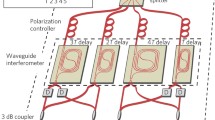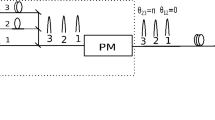Abstract.
The influence of imperfections on achievable secret-key generation rates of quantum key distribution protocols is investigated. As examples of relevant imperfections, we consider tagging of Alice's qubits and dark counts at Bob's detectors, while we focus on a powerful eavesdropping strategy which takes full advantage of tagged signals. It is demonstrated that error correction and privacy amplification based on a combination of a two-way classical communication protocol and asymmetric Calderbank-Shor-Steane codes may significantly postpone the disastrous influence of dark counts. As a result, the distances are increased considerably over which a secret key can be distributed in optical fibres reliably. Results are presented for the four-state, the six-state, and the decoy-state protocols.
Similar content being viewed by others
References
C.H. Bennett, G. Brassard, in Proceedings IEEE International Conference on Computers, Systems and Signal Processing, Bangalore (IEEE, New York, 1984), p. 175
D. Bruß, Phys. Rev. Lett. 81, 3018 (1998)
P.W. Shor, J. Preskill, Phys. Rev. Lett. 85, 441 (2000)
M. Koashi, J. Preskill, Phys. Rev. Lett. 90, 057902 (2002)
H.-K. Lo, Quant. Inf. Comput. 1, 81 (2001)
D. Mayers, J. ACM 48, 351 (2001)
For details see, for instance, related discussion in reference GLLP00
D. Gottesman, H.-K. Lo, N. Lütkenhaus, J. Preskill, Quant. Inf. Comput. 4, 325 (2004)
N. Gisin, G. Ribordy, W. Tittel, H. Zbinden, Rev. Mod. Phys. 74, 145 (2002)
N. Lütkenhaus, Phys. Rev. A 61, 052304 (2000)
G. Brassard, N. Lütkenhaus, T. Mor, B.C. Sanders, Phys. Rev. Lett. 85, 1330 (2000)
S. Felix, N. Gisin, A. Stefanov, H. Zbinden, J. Mod. Opt. 48, 2009 (2001)
H. Inamori, N. Lütkenhaus, D. Mayers, e-print arXiv:quant-ph/0107017
A.R. Calderbank, P.W. Shor, Phys. Rev. A 54, 1098 (1996); A.M. Stean, Proc. Roy. Soc. Lond. A 452, 2551 (1996)
D. Gottesman, H.-K. Lo, IEEE Trans. Inf. Theory 49, 457 (2003)
C.H. Bennett, D.P. DiVincenzo, J.A. Smolin, W.K. Wooters, Phys. Rev. A 54, 3824 (1996)
X.B. Wang, Phys. Rev. A 72, 012322 (2005)
X. Ma, B. Qi, Y. Zhao, H.-K. Lo, Phys. Rev. A 72, 012326 (2005)
C.H. Bennett, G. Brassard, N.D. Mermin, Phys. Rev. Lett. 68, 557 (1992)
M.A. Nielsen, I.L. Chuang, Quantum computation and Quantum Information (Cambridge University Press, cambridge, 2000)
The Bell states, \( \, | \rm\Phi^\pm \rangle\equiv(\, | 0 \rangle_A\otimes\, | 0 \rangle_B \pm\, | 1 \rangle_A\otimes\, | 1 \rangle_B)/\sqrt{2}\) and \(\, | \rm\Psi^\pm \rangle\equiv(\, | 0 \rangle_A\otimes\, | 1 \rangle_B \pm\, | 1 \rangle_A\otimes\, | 0 \rangle_B)/\sqrt{2}\), form an orthonormal basis in the two-qubit Hilbert space
G.M. Nikolopoulos, A. Khalique, G. Alber, Eur. Phys. J. D 37, 441 (2006)
Classical random sampling theory can be applied safely for the estimation of error rates and the establishment of related confidence levels during the verification test (see, for instance, reference LCA for details). For the sake of simplicity, throughout this work we assume that the bit-error rate estimated during the tests is the actual bit-error rate in the pairs shared between Alice and Bob
H.-K. Lo, H.F. Chau, M. Ardehali, J. Cryptology 18, 133 (2005)
M. Bourennane, F. Gibson, A. Karlsson, A. Hening, P. Jonson, D. Ljunggren, E. Sundberg, Opt. Expr. 4, 383 (1999)
M. Curty, M. Lewenstein, N. Lütkenhaus, Phys. Rev. Lett. 92, 217903 (2003)
A. Acín, N. Gisin, Phys. Rev. Lett. 94, 020501 (2005)
N. Lütkenhaus, M. Jahma, New J. Phys. 4, 44 (2002)
H.F. Chau, Phys. Rev. A 66, 060302 (2002)
D. Deutsch, A. Ekert, R. Jozsa, C. Macchiavello, S. Popescu, A. Sanpera, Phys. Rev. Lett. 77, 2818 (1996)
C.H. Bennett, G. Brassard, S. Popescu, B. Schumacher, J.A. Smolin, W.K. Wooters, Phys. Rev. Lett. 76, 722 (1996)
K. Ranade, G. Alber, J. Phys. A 39, 1701 (2006)
X. Ma, C.-H. Fred Fung, F. Dupuis, K. Chen, K. Tamaki, H.-K. Lo, e-print arXiv:quant-ph/0604094
A. Acín, J. Bae, E. Bagan, M. Baig, Ll. Masanes, and R. Mu\(\tilde{\rm n}\)oz-Tapia, Phys. Rev. A 73, 012327 (2006)
D. Mayers, A. Yao, Quant. Inf. Comput. 4, 273 (2004)
Author information
Authors and Affiliations
Corresponding author
Rights and permissions
About this article
Cite this article
Khalique, A., Nikolopoulos, G. & Alber, G. Postponement of dark-count effects in practical quantum key-distribution by two-way post-processing. Eur. Phys. J. D 40, 453–464 (2006). https://doi.org/10.1140/epjd/e2006-00167-2
Received:
Published:
Issue Date:
DOI: https://doi.org/10.1140/epjd/e2006-00167-2




